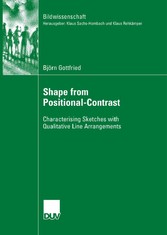Suchen und Finden
Mehr zum Inhalt

Shape from Positional-Contrast - Characterising Sketches with Qualitative Line Arrangements
Chapter 1 Sketches (p. 3)
Pictorial information is frequently used as a means of depicting both spatial and non-spatial knowledge:
1. designers develop new ideas by making sketches,
2. architects, city planners, and landscapers outline ground plans,
3. cartographers construct maps of geographic space,
4. engineers use graphical languages for modelling concepts and processes,
5. scientists visualise their experiments and observations,
6. several occupational groups make use of image databases.
The considerable increase in information available to us, especially pictorial information, poses a problem: how do we find one particular document among a vast number? An especially complex sub-problem pertains to freehand sketches, as in the cases mentioned above.
A city planner may be interested in particular configurations of geographical objects, drawing them and comparing the drawings with maps. Designers gather a great many sketches over the years, and they are sometimes interested in finding sketches which have been drawn in the past.
Both city planners and designers would bene.t from a system which can automatically search for documents which are similar to a query sketch. Indeed, digitised recordings in all sorts of areas are taken for granted today and have sometimes even become an indispensable source, for example, in archaeology, history, and the art trade.
The search for particular objects is becoming commonplace and requires sophisticated techniques which cope with queries the user speci.es graphically in order to express the visual appearance of objects which are di.cult or impossible to specify verbally. Figure 1.1 shows the sketch of an object with specific properties and an image which contains an object similar to that sketch. Some of these properties may be specifiable in language but our vocabulary is both ambiguous and limited — language cannot keep pace with drawings.
Freehand sketches are different from photos or precise graphics, because they convey objects only schematically, and we have to distinguish carefully those properties which have been drawn intentionally from those which are accidental. There is little chance that two sketches which depict the same idea will be equal from a geometrical point of view, just as there is little chance that an imprecise sketch will equal geometrically a precise picture of a similar object (see Figure 1.1).
Therefore, it is crucial to determine those characteristics which conceptually equal sketches have in common, i.e. shape information which has been drawn intentionally. Intentional shape properties are those which are necessary in order to specify an object, whereas accidental properties are unimportant for comparison purposes or even misleading.
It is the aim of the current investigation to distinguish necessary from accidental shape properties, and to compare sketched objects by means of non-accidental shape properties. We will get a first idea of how to approach this di.cult topic by looking at the omnipresence of shape information in general, and especially at the importance of shape information in drawings.
Discussing the special character of sketches, we will identify some problems which will allow us to state our objectives more precisely. These objectives will help us to deal with methodological issues.
Alle Preise verstehen sich inklusive der gesetzlichen MwSt.








